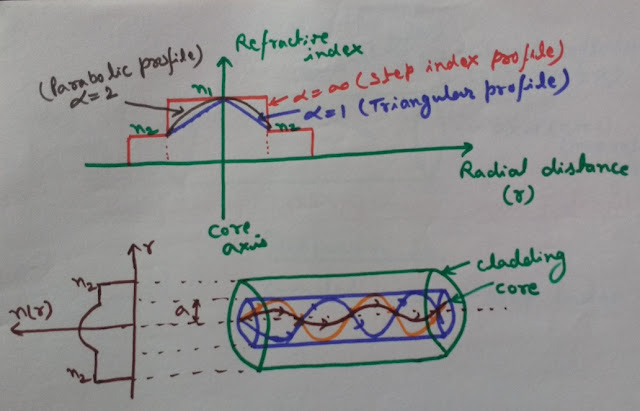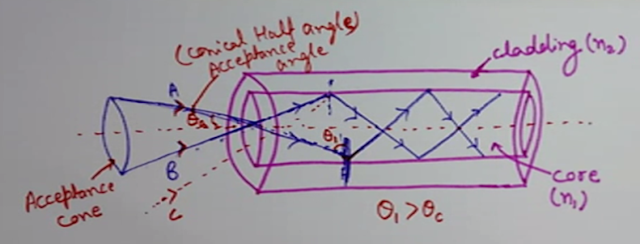There are two types of light rays on the basis of propagation inside the optical fiber-
#Meridional Rays and
#Skew Rays (Helical Rays)
Here we will discuss propagation of both types of rays-
🌓READ THIS ALSO:-
Optical Fiber Communication (Complete)
*These rays cross the fiber axis at each reflection.
The two diagrams given above show the propagation of meridional rays inside the optical fiber. The first diagram provides the ray path view along the fiber axis. It is clear from the diagram that the light ray is crossing the fiber axis at each reflection. These reflections are marked as 1, 2 and 3.
Another diagram is also of meridional ray propagation but with a different view. It is ray path view along the plane normal to the fiber axis.
Now let's discuss another kind of light ray propagation inside optical fibers i.e. Skew rays.
*Skew rays do not cross the fibre axis and propagate around the optical fiber axis on zigzag path.
*Skew rays greatly outnumber the meridional rays. *Skew rays enter the optical fiber off the fiber axis.
It should be noted here that, in case of skew rays, the point of emergence from the fiber in air depends upon the number of reflections inside the optical fibre. It does not depend upon the input conditions to the fiber.
🌓READ THIS ALSO:-
OPTICAL FIBER: STRUCTURE AND WORKING PRINCIPLE
This concept is made clear with the help of two diagrams given below.
The first diagram of skew ray shows the ray path view along the fiber axis and the second diagram shows the ray path view along the plane normal to the fiber axis.
It is clear from the second diagram that the skew ray (helical ray) is not crossing the optical fiber axis and propagating around the axis.
Read More-
Go To HOME Page
FREQUENCY SPECTRUM OF AMPLITUDE MODULATION (WAVEFORMS AND EQUATIONS DERIVATION)
AMPLITUDE MODULATION (TIME DOMAIN EQUATIONS AND WAVEFORMS)
ADVANTAGES AND DISADVANTAGES OF DIGITAL COMMUNICATION SYSTEM
ADVANTAGES OF OPTICAL FIBER COMMUNICATION
STEP INDEX OPTICAL FIBER (MULTIMODE AND SINGLE MODE STEP INDEX FIBERS)
PULSE MODULATION TECHNIQUES (PAM, PWM, PPM, PCM)
OPTICAL FIBER: STRUCTURE AND WORKING PRINCIPLE
PULSE AMPLITUDE MODULATION (PAM)
COMPARISON OF PAM, PWM, PPM MODULATION TECHNIQUES
PULSE WIDTH MODULATION (PWM)
CONTINUOUS TIME AND DISCRETE TIME SIGNALS (C.T. AND D.T. SIGNALS)
NEED AND BENEFITS OF MODULATION
PULSE POSITION MODULATION (PPM)
OPTICAL FIBERS IN COMMUNICATION: COVERS ALL IMPORTANT POINTS
OPTICAL FIBER SOURCES (DESIRABLE PROPERTIES)
AMPLITUDE MODULATION Vs FREQUENCY MODULATION (ADVANTAGES AND DISADVANTAGES)
PULSE CODE MODULATION (PCM) [ADVANTAGES AND DISADVANTAGES]
SAMPLING THEOREM AND RECONSTRUCTION (SAMPLING AND QUANTIZATION)
SUPERPOSITION THEOREM (BASICS, SOLVED PROBLEMS, APPLICATIONS AND LIMITATIONS)
Digital Modulation Techniques (ASK, FSK, PSK, BPSK)/ Amplitude, Frequency and Phase Shift Keying
Conventional AM Vs DSB-SC Vs SSB-SC Vs VSB (Comparison of AM Systems)
Quadrature Amplitude Modulation (QAM)/ QAM Transmitter and QAM Receiver Block Diagram
Single-Mode Optical Fiber Advantages
What are Microwaves and their Applications (Uses) in various fields
Microwaves Properties and Advantages (Benefits)
Basic Structure of Bipolar Junction Transistor (BJT) - BJT Transistor - Working and Properties
Polar Plots of Transfer Functions in Control Systems (How to Draw Nyquist Plot Examples)
Generation of Binary Phase Shift Keying (BPSK Generation) - Block Diagram of Binary Phase Shift Keying (BPSK)
Low Level and High Level Modulation Block Diagram (AM Transmitter Block Diagram)
Block Diagram of CRO (Cathode Ray Oscilloscope), Components of CRO and CRT with Structure and Working
Slope Overload Distortion and Granular (Idle Noise), Quantization Noise in Delta Modulation
Frequency Translation/Frequency Mixing/Frequency Conversion/Heterodyning (Basic Concepts and Need)
Quadrature Phase Shift Keying Modulation (QPSK) Basics, Waveform and Benefits
Pulse Code Modulation (PCM) Vs Differential Pulse Code Modulation (DPCM)
#Meridional Rays and
#Skew Rays (Helical Rays)
Here we will discuss propagation of both types of rays-
🌓READ THIS ALSO:-
Optical Fiber Communication (Complete)
Meridional Rays
*Meridional rays enter into the optical fiber through it's axis.*These rays cross the fiber axis at each reflection.
 |
| Meridional Rays Propagation Inside Optical Fiber |
The two diagrams given above show the propagation of meridional rays inside the optical fiber. The first diagram provides the ray path view along the fiber axis. It is clear from the diagram that the light ray is crossing the fiber axis at each reflection. These reflections are marked as 1, 2 and 3.
Meridional and Skew Rays Video
Another diagram is also of meridional ray propagation but with a different view. It is ray path view along the plane normal to the fiber axis.
Now let's discuss another kind of light ray propagation inside optical fibers i.e. Skew rays.
Skew Rays (Helical Rays)
*Skew rays are also known as helical rays as they move on helical path inside the optical fiber.*Skew rays do not cross the fibre axis and propagate around the optical fiber axis on zigzag path.
*Skew rays greatly outnumber the meridional rays. *Skew rays enter the optical fiber off the fiber axis.
It should be noted here that, in case of skew rays, the point of emergence from the fiber in air depends upon the number of reflections inside the optical fibre. It does not depend upon the input conditions to the fiber.
🌓READ THIS ALSO:-
OPTICAL FIBER: STRUCTURE AND WORKING PRINCIPLE
This concept is made clear with the help of two diagrams given below.
 |
| Skew Rays (Helical Rays) Propagation Inside Optical Fiber |
The first diagram of skew ray shows the ray path view along the fiber axis and the second diagram shows the ray path view along the plane normal to the fiber axis.
It is clear from the second diagram that the skew ray (helical ray) is not crossing the optical fiber axis and propagating around the axis.
Read More-
Go To HOME Page
FREQUENCY SPECTRUM OF AMPLITUDE MODULATION (WAVEFORMS AND EQUATIONS DERIVATION)
AMPLITUDE MODULATION (TIME DOMAIN EQUATIONS AND WAVEFORMS)
ADVANTAGES AND DISADVANTAGES OF DIGITAL COMMUNICATION SYSTEM
ADVANTAGES OF OPTICAL FIBER COMMUNICATION
STEP INDEX OPTICAL FIBER (MULTIMODE AND SINGLE MODE STEP INDEX FIBERS)
PULSE MODULATION TECHNIQUES (PAM, PWM, PPM, PCM)
OPTICAL FIBER: STRUCTURE AND WORKING PRINCIPLE
PULSE AMPLITUDE MODULATION (PAM)
COMPARISON OF PAM, PWM, PPM MODULATION TECHNIQUES
PULSE WIDTH MODULATION (PWM)
CONTINUOUS TIME AND DISCRETE TIME SIGNALS (C.T. AND D.T. SIGNALS)
NEED AND BENEFITS OF MODULATION
PULSE POSITION MODULATION (PPM)
OPTICAL FIBERS IN COMMUNICATION: COVERS ALL IMPORTANT POINTS
OPTICAL FIBER SOURCES (DESIRABLE PROPERTIES)
AMPLITUDE MODULATION Vs FREQUENCY MODULATION (ADVANTAGES AND DISADVANTAGES)
PULSE CODE MODULATION (PCM) [ADVANTAGES AND DISADVANTAGES]
SAMPLING THEOREM AND RECONSTRUCTION (SAMPLING AND QUANTIZATION)
SUPERPOSITION THEOREM (BASICS, SOLVED PROBLEMS, APPLICATIONS AND LIMITATIONS)
Digital Modulation Techniques (ASK, FSK, PSK, BPSK)/ Amplitude, Frequency and Phase Shift Keying
Conventional AM Vs DSB-SC Vs SSB-SC Vs VSB (Comparison of AM Systems)
Quadrature Amplitude Modulation (QAM)/ QAM Transmitter and QAM Receiver Block Diagram
Single-Mode Optical Fiber Advantages
What are Microwaves and their Applications (Uses) in various fields
Microwaves Properties and Advantages (Benefits)
Basic Structure of Bipolar Junction Transistor (BJT) - BJT Transistor - Working and Properties
Polar Plots of Transfer Functions in Control Systems (How to Draw Nyquist Plot Examples)
Generation of Binary Phase Shift Keying (BPSK Generation) - Block Diagram of Binary Phase Shift Keying (BPSK)
Low Level and High Level Modulation Block Diagram (AM Transmitter Block Diagram)
Block Diagram of CRO (Cathode Ray Oscilloscope), Components of CRO and CRT with Structure and Working
Slope Overload Distortion and Granular (Idle Noise), Quantization Noise in Delta Modulation
Frequency Translation/Frequency Mixing/Frequency Conversion/Heterodyning (Basic Concepts and Need)
Quadrature Phase Shift Keying Modulation (QPSK) Basics, Waveform and Benefits
Pulse Code Modulation (PCM) Vs Differential Pulse Code Modulation (DPCM)









